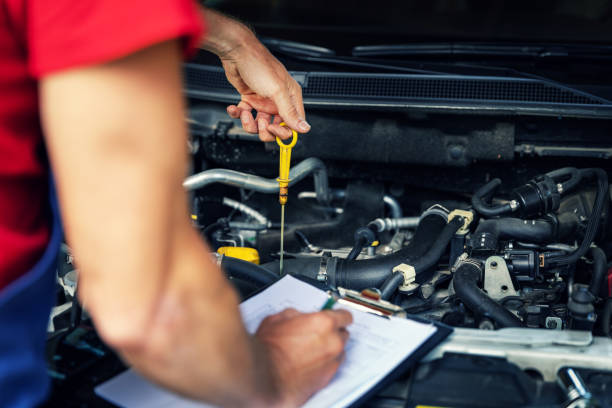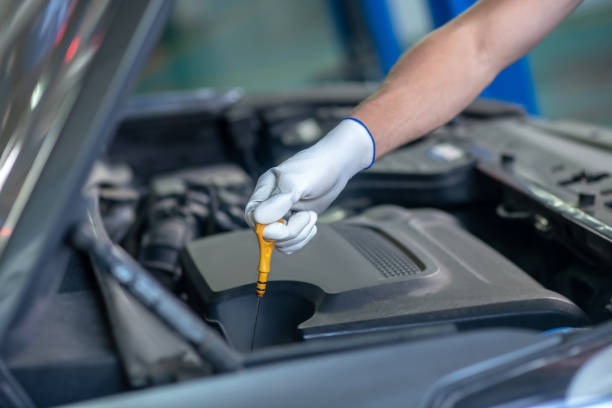Engine Oil Dipstick Hard To Read – How?
When it comes to maintaining the life of your car, having the oil checked is always a necessity. Checking to make sure your car’s engine has enough oil is the best way to help keep it running at its best for a long time to come. To know the condition as well as the oil level in the engine, drivers always use the dipstick to check the health of the engine. For some reason, the engine oil dipstick hard to read, how can we see that? Let’s find the answer in the article!
What is The Engine Oil Dipstick?
Engine oil check plays an important role in maintaining the operation of the car engine system. This solution has the effect of lubricating, reducing friction, and cleaning the internal parts of the engine. You can notice and understand what is happening with the oil inside the engine if you check the condition of the engine oil regularly. And dipstick is a useful tool that helps you do the process simply and quickly.
All internal combustion engines have an engine oil dipstick and it also includes diesel engines as well. The dipstick is a long, flat metal rod to measure the level of liquids, especially oil in a car engine.
The position of the dipstick depends on your type of car engine. Usually, what you see in the engine compartment will be the oil dipstick handle, which looks like a yellow plastic ring, with the “Engine Oil” text.

Step by Step to Check When The Engine Oil Dipstick Hard to Read?
If you’re having trouble reading the dipstick on your car, it could be because the oil has cooled down. When the oil cools, the viscosity is high and the dipstick is difficult to read. If the engine oil dipstick hard to read, you can add at least a liter of oil to the engine. It is important to keep the engine oil level at the correct level to protect the engine from wear and to ensure proper lubrication. How to read the oil level on the dipstick correctly, follow the steps below:
Step 1: Park the car on a flat surface and turn off the engine
Try to find a relatively flat surface to park and check the oil. You need to do this to be able to accurately read the information on the dipstick. For example, if the car is on a sloped surface, the oil dipstick may be misread.
You should wait at least 10 minutes after turning off the engine or check the oil when the engine is cold:
- Do not check the engine oil while the car is running.
- Make sure the engine has been idle for a few minutes.
- Wait a few minutes to check the oil so you can make sure that any oil near the top of the engine can drain to the bottom.
Step 2: Open the hood and identify the position of the dipstick.
Do not confuse the engine oil dipstick and transmission dipstick. If you are not sure which dipstick to use, check the manual that came with your car. Some newer models have an electronic oil display and don’t have a traditional dipstick for manual checking.
Step 3: Pull out the dipstick and clean off
This is a very important step. Use a rag to clean the bottom of the dipstick, it will help you get rid of any residual oil that could be splashed around on the dipstick and you can read the level of oil accurately.
Step 4: Reinstall the oil dipstick in the engine
Put the oil dipstick in the engine as it was. Push it all the way down until it is completely reassembled. If there is a squeak when reinstalling, pull it out, clean it and try again.
Step 5: Pull the dipstick out again
Take out the dipstick and hold it in a horizontal position, find the exact spot on the dipstick. Where should oil be on the dipstick? Near the end of the oil dipstick, there will be two marks that are standard for “low” and “full”, the lower line is the minimum oil level, and the upper line is the maximum oil level. If the oil streak is in between the two lines, the oil is at a stable level, good for the engine. If the oil level is close to or below the minimum, you need to add more oil.
Make sure the dipstick will show the correct condition of your engine oil, let’s look at the tips below:
- You should observe and make sure the oil dipstick is in good condition. If it is damaged or loose, the dipstick can make incorrect results and make it hard to read.
- Make sure that the dipstick is clean and doesn’t have any debris. This will help reduce friction when reading the dipstick.
- You should notice whether the dipstick is pointing in the right direction? If not, you need to change it.

FAQs
What happens if the oil level is too high?
In certain cases, the oil level may have increased since you last checked the oil or there is too much oil on the dipstick. This could be due to condensate (from combustion), or a coolant leak – all of which can be causes for concern.
The car’s crankshaft is aerated when overfilling engine oil. Foaming oil doesn’t lubricate your vehicle well, and in many cases, it will stop the flow of the oil completely, overheat your oil and cause a drop in oil pressure.
Signs of aging oil
We need to change our oil on time as it is influenced by driving conditions, fuel quality, engine age, and climate. If not, the oil will degrade and not protect your engine. So look closely at the oil on the dipstick:
- The oil looks pretty clear like golden honey: in good condition
- Dark brown to black oil: Need to change the oil
>> Read more: What Should be the Oil Changing Frequency in Winter?
How do I know the coolant leak by dipstick?
If the coolant leaks, the cooling process will not reach optimal performance, and the engine will overheat. Using the dipstick will help you detect this problem earlier and have a timely remedy. Brown bubbles or solid brown deposits above the level mark on the dipstick could be an indication that coolant has leaked into your engine.
Another sign is sweet-smelling white exhaust smoke. In this case, the oil level from the dipstick may actually increase, indicating that a significant amount of coolant has leaked into the oil tank. If you look at the coolant in your engine oil, your engine should be maintained immediately.
How can I read the oil dipstick with 4 dots?
Reading a 4 dots dipstick has a little bit challenging if you are a beginner. But it is not difficult as you think. We will tell you the detailed way to do that:
- First, you need to adjust the lighting angle and distance between the dipstick and the reader. Once you’ve done this, you’re ready to start reading!
- Identify 4 marks. The 4 dots on the dipstick correspond to 4 different levels of engine oil. To read it, you will need to determine which dot corresponds to which degree of oil level.
- Read between marks – If there is heavy oil, it will cause the line on the dipstick to stay still while the other lines move around it. This means you will need to read between those marks to get the correct result!
Conclusion
Taking a minute can help keep your car running smoothly. Checking your car’s engine oil regularly is an important part of keeping the engine running smoothly and driving the most kilometers. Every regular car user, everyone needs to understand the role and how to use the oil dipstick. This will help maintain the life of the engine, which is likened to the “heart” of the car.
A healthy, durable engine will make each of our journeys with loved ones and family safer and more enjoyable. Car From Japan hopes that the article will help you know the way to see when the engine oil dipstick hard to read.














